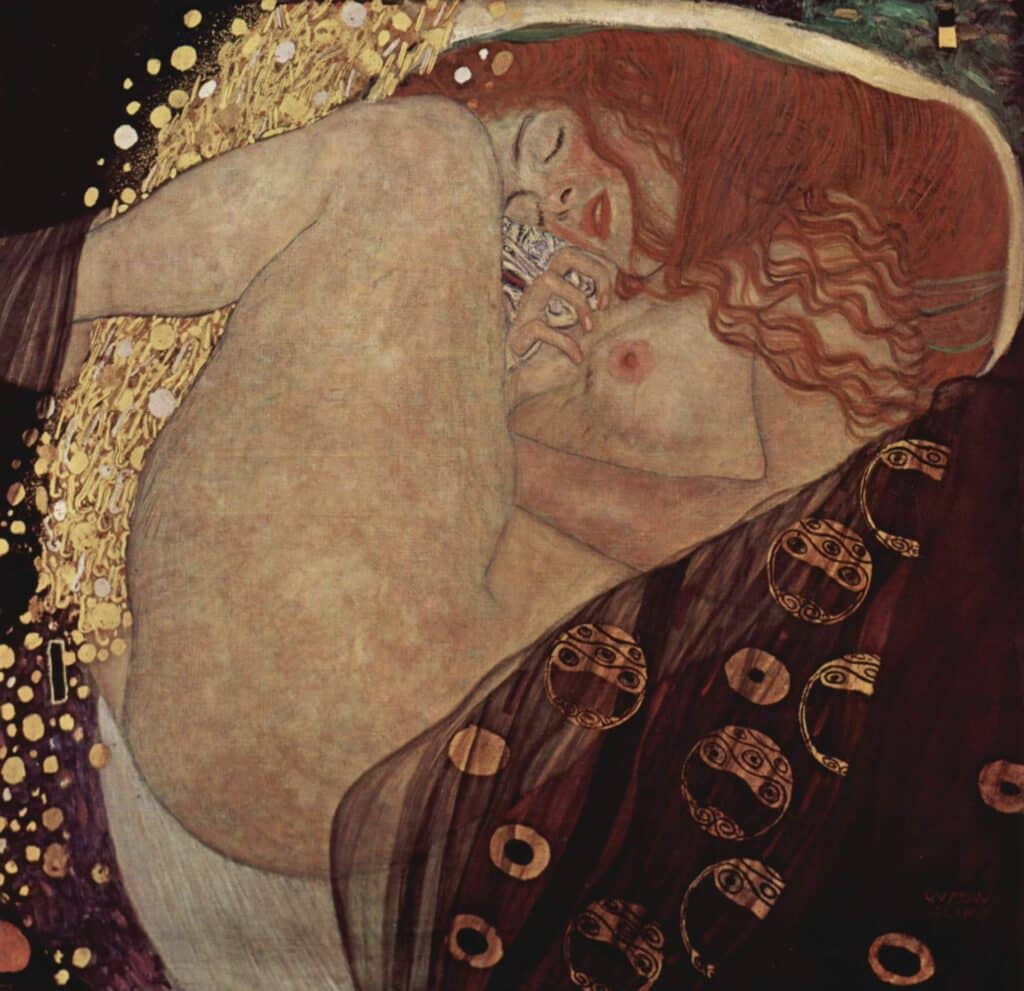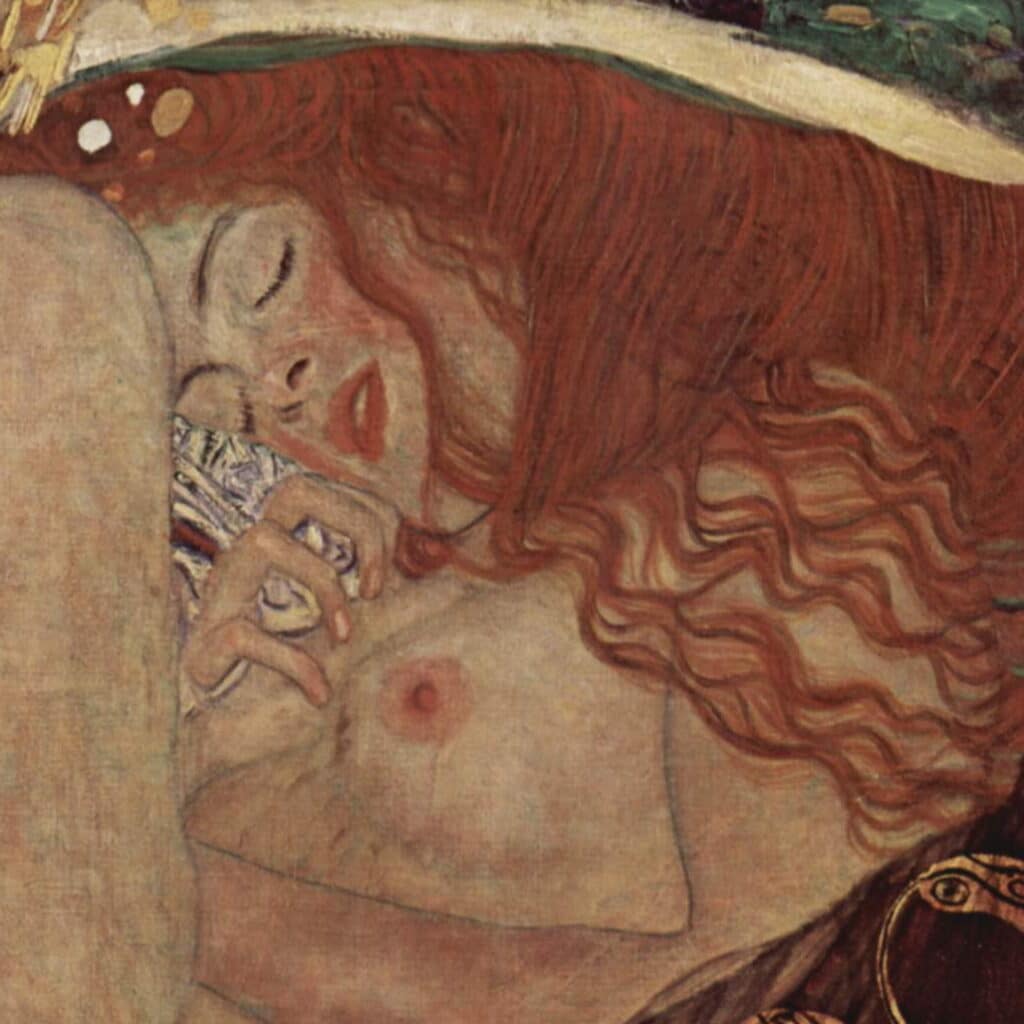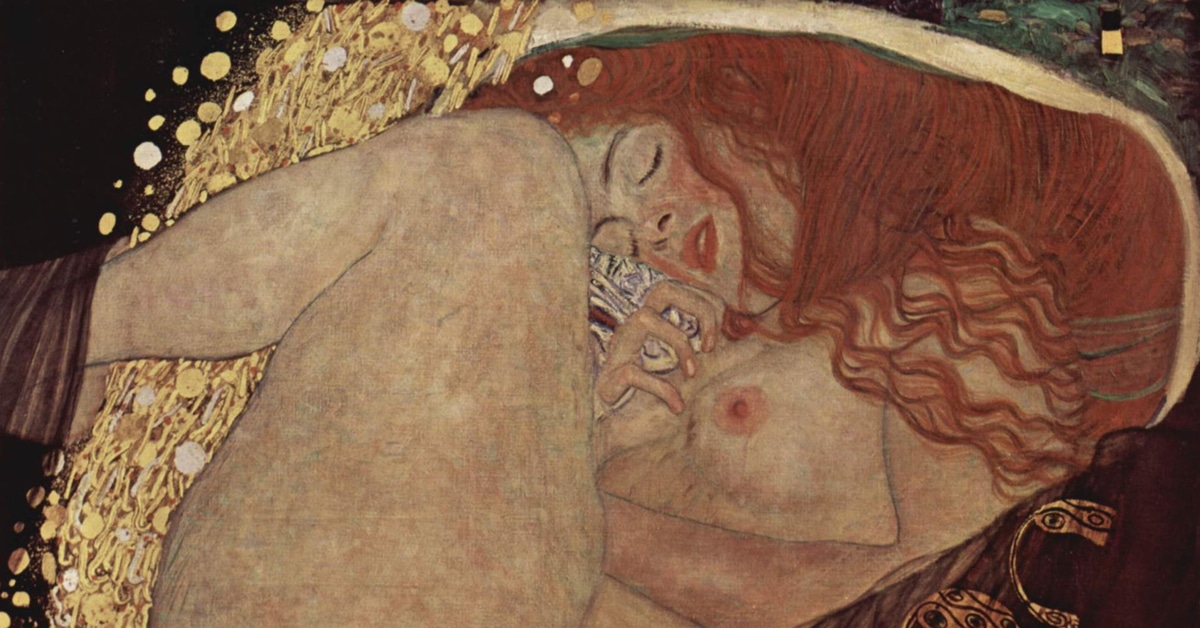What have you heard about the Greek symbol of modesty, Danae? Well, for centuries, Danae was a popular inspirational and mythological figure for artists. It turns out that Gustav Klimt was no exception.
Klimt created his interpretation of Danae in 1907. This painting is an ideal representation of transcendence and heavenly love and is quite erotic. The artwork is a focal point in Klimt’s artistic life.
Danae is one of his most recognizable works, as well as the one that brought him both critical acclaim and commercial success. This kind of lavish ornamentation is also evident in images like his well-known “Kiss,” which was made the same year as Danae.
Painting Technique Used In Danae
After the untimely passing of his father and sibling, Gustav, the third of three brothers, produced his most famous masterpieces. The artist began learning about symbolism and modern art at that time in his life. His paintings typically feature a female figure clothed in powerful eroticism. He became one of the most significant figures in the Vienna Secession movement due to his fondness for the feminine form and symbolism.
Gustav Klimt favored curves and lines. The line, which is roughly shaped like an S, is an idealized version of natural shapes like plant branches and flower petals. It is a sinuous ribbon that flexes in unexpected places. Those whiplash lines, so fashionable at the start of the previous century, are typical of Art Nouveau.
With Klimt, the Art Nouveau curve may bend back on itself several times. In order to mimic the contours of the human figure, it also tends to have a more bulbous and rounder appearance.
The secret to Klimt’s inventiveness is his method of closely cropping his pictures, which causes his figures to be crammed into small places. This approach makes the curving lines visible and always in conversation with the canvas’s straight-edge border.
To emphasize how intimate the space is, Klimt creates a specific line movement. The downward flow of the gold, which is repeated by Danae’s hair’s flow, is combined by Klimt with a perpendicular flow of her hair that runs across her shoulder and lines up with the position of her face.
Also, her thigh’s shape is nearly identical to the contour of her head and hair despite being twisted at an angle of around 90 degrees. In the translucent cloth that cascades down the right side, the same wide form is twisted and repeated once again.

What Does Danae Painting Represent?
Gustav Klimt, an Austrian painter, created Danae in 1907 as a symbolist Art Nouveau work. Princess Danae is depicted in his picture as being held captive by the king in a bronze tower. Zeus visited her during that time, appearing to her as a golden shower that fell between her legs. The golden stream has an enticing effect on Danae, as shown in her expression.
It depicts ladies from classical myth being tempted by the god Zeus. Indicative of Danae’s sensuous experience are her opened lips and legs, closed eyelids, rolled-down stockings on her ankles, red hair, and gauzy purple veil. This is an extremely sexual piece of art since Danae’s thighs occupy over a fourth of the image’s surface.
In his depiction of the mythical Danae, Klimt encircled his subject in a plethora of interlacing lines that ensconced her in a solitary moment of bliss. Her body’s fetal-like inward curling and the intimate closeness of the canvas area create a sensual climax that swirls and unfolds.
The flowing golden shape appears to focus and break apart in a flurry of emotion. The early viewers of the picture must have been astonished by Danae’s honest representation of pleasure, which was considered radical and scandalous at the time even though numerous Symbolist paintings frequently featured such open images of female sexuality.
The woman is shown in a condition of lavish indulgence, with her auburn hair cascading in opulent strands across her face and broad, nacreous skin. She rests in an ill-defined area, coiled in climatic contentment with a raveled stocking around her ankle, half covered in a flowing, translucent veil in the classic colors of luxury: gold and purple.
These cues reveal her royal persona to the onlooker. The composition of Danae in her unusually contorted position is unusually dominated by her thigh, as already mentioned above. This assumes enormous proportions and fully emphasizes the piece’s overt sexuality. This intensity is only partially offset by the distracting effects of the lavish decoration and the abstraction of the nearby patterns.
The woman’s body position appears to partially mimic an embryonic state, and the flat boundaries of the abstract painted forms support this further. They give the impression that the woman is enclosed and safe within the protective sphere of her own sexual transport, free from the worries of the outside world.

Inspirational Myth About Danae
Acrisius, the king of Argos, had a daughter named Danae. This myth is about fate’s inescapability and is found in many old tales. King Acrisius imprisoned the childless Danae in a cell to keep her away from possible suitors after he learned from the oracle that his daughter’s offspring would one day murder him. The ever-amorous Zeus, king of the gods, however, did not let her captivity stop him from visiting her. He appeared as a shower of gold and rushed through the skylight. Danae became pregnant, and Perseus was born.
The two were imprisoned in a box and thrown into the water while King Acrisius continued to fight the prophecy. But Poseidon made it possible for Danae and her child to live. Later, when playing sports in the city of Larissa, Perseus accidentally killed his elderly grandfather with a discus, and that is how the prophecy was fulfilled.
The time of Zeus’ entrance and his impregnation of Danae in the guise of a golden rain was preferred by artists who depicted the Danae tale. Frequently, it is depicted as falling from the sky like dazzling rain during a storm. Other representations, most notably a few by Titian, show the golden rain as coins, emphasizing the desired nature of Zeus’ appearance by having Danae or her maidservant actively capture the downpour.
Due to Danae’s forced imprisonment in the tower, she was transformed during the Middle Ages into a Christian icon of virginity as a response to the tale’s sensual overtones. She was also a suitable classical prefiguration of the Annunciation when the Virgin Mary became pregnant only via divine intervention due to the mystic character of her impregnation. As a result, Danae became a favorite subject for Renaissance artists, who used her as a metaphor for the transforming power of divine love.
Danae’s story’s sensual overtones are pushed blatantly in Klimt’s Danae artwork. The chamber’s decor and her personal maidservant are no longer there. Danae is portrayed as being by herself, carefree, and draped in a gauzy purple veil, the typical hues of opulence and royalty. Additionally, Klimt retells the narrative with Danae as an active and eager participant in the sexual drama, unlike earlier versions that masked the carnal side with the euphemism of “gold treasure.”
Sensual Lines In Klimt’s Artworks
The continual conflict between depiction and abstract patterning was a feature of Klimt’s painting technique. His artwork frequently incorporates or brushes up against parts of the realistic style with ornamental themes.
Another piece of art, “Goldfish,” that Klimt produced in 1902, was created by a similar technique as Danae. Abstract components and the people in the painting blend as your eye moves up and down the image. Klimt creates the kind of billowing swells seen in musical instruments like violins and cellos by using lines that are continually bending and undulating.
We can see why Klimt liked painting the human body in works like Goldfish. This is because he enjoyed the looped, twisted, and meandering patterns. All this allowed him to idealize female forms.
Danae and Goldfish, two of his works, have a lot in common. The color scheme is the same, consisting of purples, golds, and rusty oranges. Klimt placed the women’s bodies at the center of both works, covering vast areas of the canvas with exposed flesh while keeping the details of their faces slightly in the background, taking up a smaller and more condensed portion of the image. This push-pull dynamic, which forces the observer to interpret a sometimes baffling painted environment, is a specialty of Klimt’s.
However, the closeness is stronger in Danae, the latter of the two paintings. There is hardly any air left for breathing. She is near enough to touch her white thighs, which have faint blue vein splotches.
Final Thoughts
All in all, Klimt’s Danae is a clearly erotic creation that has become one of the most interesting art pieces. The sketches of the painting are eventually more voyeuristic than the completed piece. Currently, this masterpiece is kept at the Leopold Museum in Vienna, Austria.
Even though Klimt’s work is very widely admired by the general public, art criticism tends to downplay its effect. Klimt’s works mixed sexuality with art in a manner that was quite divisive at the time. One instance of this is given by Danae, who also ties the concept into a mythological topic.
